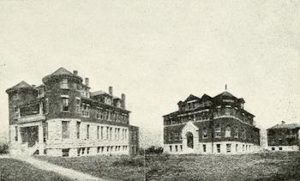
Old Building Memories
*The founding of Western University (Kansas) is celebrated on this date in 1865. This was a historically black college (HBCU) established as the Quindaro Freedmen's School.
Located in Quindaro, Kansas, it was the earliest school for Blacks west of the Mississippi River and the only one in Kansas. The town was founded in 1856 by abolitionists, Wyandot, free Black individuals, and settlers from the New England Emigrant Aid Company; the first land shares were sold in 1857. The latter had come from Massachusetts and other northeast states to help Kansas become a free rather than slave state, a question to be settled by its voters. They started building buildings in January 1857, and a hundred were built in the first year. The first classes of what became Western University were started by Eben Blachley in his home in 1862, who taught the children of freedmen.
Most of the homesites of Quindaro were on the bluff; the port's commercial district was in the bottomland near the level of the Missouri River below the bluffs. As a stop on the Underground Railroad, Quindaro absorbed or assisted fugitive slaves before the American Civil War and many contrabands (fugitive slaves behind Union lines), especially from Missouri, during the war. After the war, a committee of white men in the community, former abolitionists, organized a school to educate those resettled in Quindaro and the Kansas City area. In 1865, the committee registered their county charter for what they called Quindaro Freedman's School. In 1867, the state legislature approved funds for the school. In 1872, the state increased funding to establish a four-year normal school curriculum to train teachers.
Charles Henry Langston, a prominent activist, politician, and grandfather of poet Langston Hughes, was named principal of the normal school. Freedmen and blacks, free before the war, believed that education was key to advancing their race. State financial difficulties led to a reduction in support following the Panic of 1873, and the school had to decrease its enrollment. Blachley continued his support, bequeathing 100 acres (0.40 km2) of land in the 1870s to help support the college that had developed from his first classes. In the 1880s, Exodusters and other migrants significantly contributed to the growth of the Black population in Kansas. The college resumed its activities. In the late 19th century, the African Methodist Episcopal (AME) Conference began to help financially support the school. Quindaro added a theological course and constructed Ward Hall in 1891 to accommodate it; the hall was named after a bishop of the African Methodist Episcopal (AME) Church.
In 1896, William Tecumseh Vernon, a young AME minister, was appointed president. He worked to increase state funding. In 1899, he gained legislative approval and financial support to incorporate industrial education into the college, which prompted the construction of numerous structures for the new classes and dormitories. Kansas City annexed the area of the Quindaro settlement in the early 20th century. Industrial courses were modeled after the Tuskegee Institute, offering commercial business courses, drafting, printing, carpentry, and tailoring. Later, blacksmithing and wheelwrighting were added to prepare students with the desired skills for making a living. The campus was expanded with training buildings to house livestock and another for laundry. Later, a building was added to teach auto mechanics and repair. A central steam plant was added, as were additional dormitories.
From 1916-1918, Inman E. Page was president. Composer and music educator L. Viola Kinney led the school. Western University was lauded in the early 20th century for its outstanding music program. The Jackson Jubilee Singers toured from 1907 to 1940 and appeared on the Chautauqua education circuit. Among the university's most notable alums were several women who were influential music pioneers in the early 20th century, including Eva Jessye, Nora Douglas Holt, and Etta Moten Barnett.
The Great Depression reduced the availability of financial support, and the university faced increasing competition to attract students. Western University closed in 1943. Nothing but the cornerstones of the earliest two halls still exist at the townsite. Some buildings were lost to fire, while others were demolished as the sites were redeveloped. The last historic structures remaining were three faculty houses, which were demolished near the end of the 20th century.